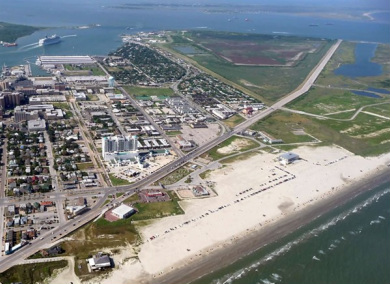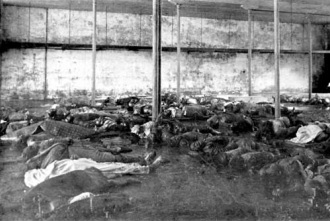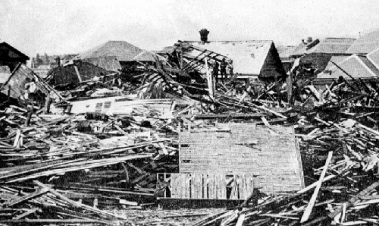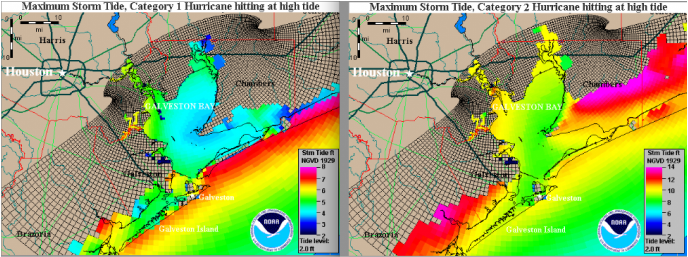Galveston, Texas
September 8, 1900

The city of Galveston was founded in 1839 and continuously were hit by storms. Before the 1990s, Galveston, Texas had been one of the richest cities in the United States. Little did they know that a hurricane was coming their way and would destroy their land. The Galveston Hurricane is known as the worst natural disaster in American history, as it hit the town of Galveston as a category four storm. Although it is sometimes forgotten or not as well known as Hurricane Katrina, Hurricane Galveston brought much sorrow and change. But with the struggles and challenges that the people of Galveston faced, they were still able to succeed in reconstructing their homeland. Today, Galveston is the internal place for major cruise ports, an insurance corporation, two universities, and preserved buildings that had survived the hurricane. These buildings give Galveston a "Victorian look" and help remind the people of Galveston about their survival and their success in rebuilding. Because Galveston was such a rich city, it was highly believed that business would eventually return to normality and function prosperously, as done before the hurricane.
Location.

Galveston was home to 38,000 people. The storm came off the Gulf of Mexico into a Galveston, a city barely above sea level. Galveston is a sand island, 30 miles by 1.5-3 miles in size with a narrow bay of 2 miles in width; its discharge passes through the San Louis Pass in order to reach the Gulf of Mexico. Even though the island is higher than the mainland, and the mainland is used to overflowing from high tides, Galveston was hopeless when the hurricane hit. The northeastern side of the city did not suffer nearly as much damage as other located districts because the northeastern had protection from the South Jetty.
Little Warning.
Typically when hurricanes are approaching there will be signs such as a brick-dust sky. But for Galveston, there was not warning. During the afternoon of September 7th, a heavy swell (from southeast) approached the Gulf of Mexico and continued throughout the night as the tide rose to an unusual height. When storm warnings finally hit, the coast received a notice of caution. On the morning of the 8th, a man was kept on the telephone to give information to the Central Office at Washington. Unlike this man, many other people weren’t able to reach help by telephone and therefore searched for advice at the Weather Bureau office. As the wind continued, the public was warned by telephone and verbally to find a secure place for the night because the worse winds had yet to come from east to the south. Many families that lived in small houses on the beach moved to the center of the city. At about 3pm, the man sent a special report to Washington because conditions became very threatening.
· 3:30pm: “Gulf rising, water covers streets of about half of city”
· Telegraph wires down
· Barometer below 29.00 inches
· Advised everyone to go to center of the city
When it reached rid-morning, the winds picked up and the skies were covered with clouds. The intensity and darkness inclined as morning turned to afternoon. The storm stayed until early the next day and left people to wake up to devastation, with many dead bodies and few buildings remained standing. After about 3am, the water finally went down.
· 3:30pm: “Gulf rising, water covers streets of about half of city”
· Telegraph wires down
· Barometer below 29.00 inches
· Advised everyone to go to center of the city
When it reached rid-morning, the winds picked up and the skies were covered with clouds. The intensity and darkness inclined as morning turned to afternoon. The storm stayed until early the next day and left people to wake up to devastation, with many dead bodies and few buildings remained standing. After about 3am, the water finally went down.
Devastation.

The Galveston Hurricane was a devastating time period when many people died or were severely hurt. More than 8,000 people died from the hurricane storm tides. Flying items, the flooding, the winds and more killed people. There were so many corpses that several were brought in loads of wagons, laid down in rows to be identified, and then decamped, burned, or brought out to sea to be dumped. Even when they streets were not yet clean, dead bodies were still daily found amongst the debris. The destruction of homes was also a serious issue after the hurricane. About 3,636 houses were completely destroyed (almost half the homes of Galveston residence.) The value of all the building destruction was estimated to be more than $700 million
Try and picture what Galveston looked like after the hurricane
· Streets full of tops and sides of houses
· Winds up to 135 mph
· Propelled 15-foot flows of water
· Water swamped the 8.7 foot high island
· Total tide in locality: about 20 feet
· Streets full of tops and sides of houses
· Winds up to 135 mph
· Propelled 15-foot flows of water
· Water swamped the 8.7 foot high island
· Total tide in locality: about 20 feet
How Galveston Improved Their Community.
Before the hurricane, Galveston had been home to one of the busiest ports in Texas and promised the title of the “New York of the South.” But with the storm, shippers were convinced to move north to a safer city, Houston. Many goods and supplies that were less than eight feet were injured or lost. Actions were taken in order to improve and prevent another destruction in Galveston. The land was raised about 17 feet in elevation. They pumped dredged sand beneath their foundation in an effort to raise the elevation so it would be harder for Galveston to flood. In the process, over 2,100 buildings were raised (including the 3,000-ton St. Patrick’s Church.) A seawall was also built along the island’s oceanfront and extended 10 miles. The idea and inspiration for the seawall came after broken up pieces of building that were near the beach, floated toward land and created a pile of rubble. This pile (to some extent) created a barrier that saved some buildings behind it from destruction. This convinced the people that the seawall really did work and that is was necessary to have incase of another natural disaster. The seawall was developed by three engineers: Henry M. Robert, H.C. Ripley, and Alfred Noble. Robert and Ripley were members of the Army Corps of Engineers while Noble was an experienced engineer from Chicago. These men proposed to make a 17 foot high seawall above seal level, which the Deep Water Committee (the committee in control of the seawall project) accepted too.

Top of foundation: wooden forms built 60 feet in length
---Base: 15 feet thick
---Top: 5 feet wide and 17 feet high
---Capped: with granite
---Gulf Side: concave to allow waves to hit
---Bocks of Granite: help break up wave action and protect foundation
---October 27, 1902 until July 30, 1904
---Cost: $1,6 million
---Success in hurricanes in: 1909, 1915, 1919, 1932, 1941, 1943, 1949, 1957, 1961, 1983
Today, hotels are built along it to help show how much protection people thought it gave them in case of future storms. The American Society of Civil Engineers named the seawall a National Historical Civil Engineering Landmark in 2001. Another piece of change was the structure of the railroad bridges. They were to be built ten feet higher and constructed by the Southern Pacific Company to withstand a hurricane so devastating as Hurricane Galveston.
Texas Hurricane History.
-1909: Devastating winds passed directly over Velasco, Texas
-1915: A very large and violent storm hit Galveston. Storm tides above 12 feet (despite 10-foot seawall) and 275 people lost their lives.
-1919: Fourth most intense and deadly storm of 20th century hit Corpus Christi (Southern Texas)
-1943: Category 1 storm hit Houston and disrupted war production (WWII) and increased the death toll
-1957: Hurricane Audrey it near Texas-Louisiana border with devastating effects. There were 390 deaths and damages at about $700 million (in 1990 dollars)
-1967: Hit between Brownsville, TX and mouth of Rio Grande. About 15 deaths in Texas and a damage of $900 million in 1990 dollars
-1970: Hurricane Celia, one of the most destructive storms to hit Texas. Damage of $1.6 billion (in 1990 dollars)
-1983: Alicia was the first hurricane to strike Continental USA since ALlen in 1980. Minimal Category 3 status and moved over Texas southwest of Galveston. Damage of over $2.4 billion (in 1990 dollars)
-1988: Hurricane Gilbert, one of the most powerful of the century at a Category of a 5 storm. Total of 318 killed and a damage between $40-50 billion (in 1990 dollars) in Texas
-1999: Hurricane Brett hit the south of Texas coast. Caused about $60 million in damage, but no deaths. First hurricane that affected south Texas since Hurricane Allen in 1980
-1915: A very large and violent storm hit Galveston. Storm tides above 12 feet (despite 10-foot seawall) and 275 people lost their lives.
-1919: Fourth most intense and deadly storm of 20th century hit Corpus Christi (Southern Texas)
-1943: Category 1 storm hit Houston and disrupted war production (WWII) and increased the death toll
-1957: Hurricane Audrey it near Texas-Louisiana border with devastating effects. There were 390 deaths and damages at about $700 million (in 1990 dollars)
-1967: Hit between Brownsville, TX and mouth of Rio Grande. About 15 deaths in Texas and a damage of $900 million in 1990 dollars
-1970: Hurricane Celia, one of the most destructive storms to hit Texas. Damage of $1.6 billion (in 1990 dollars)
-1983: Alicia was the first hurricane to strike Continental USA since ALlen in 1980. Minimal Category 3 status and moved over Texas southwest of Galveston. Damage of over $2.4 billion (in 1990 dollars)
-1988: Hurricane Gilbert, one of the most powerful of the century at a Category of a 5 storm. Total of 318 killed and a damage between $40-50 billion (in 1990 dollars) in Texas
-1999: Hurricane Brett hit the south of Texas coast. Caused about $60 million in damage, but no deaths. First hurricane that affected south Texas since Hurricane Allen in 1980
Fun Facts.
The last survivor of the Galveston Hurricane of 1900, was Mrs. Maude Conic of Wharton, whom died November 14th, 2004 and was claimed to be 116 years old (while records indicate she was younger.)
Click the links below to learn more about Hurricane Galveston and Hurricane Katrina, as well as how they connect and how the government effected each of them.
Galveston
Galveston Blogs
Katrina
Katrina Blogs
The Governments Involvement in the Hurricanes
The Comparing and Contrasting of Hurricane Katrina and Hurricane Galveston




